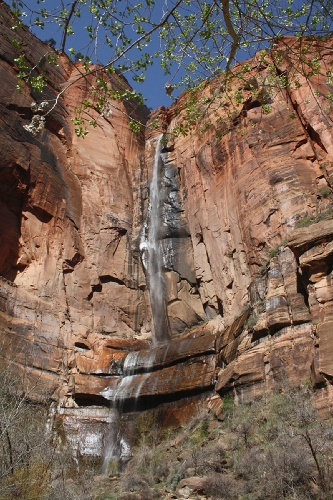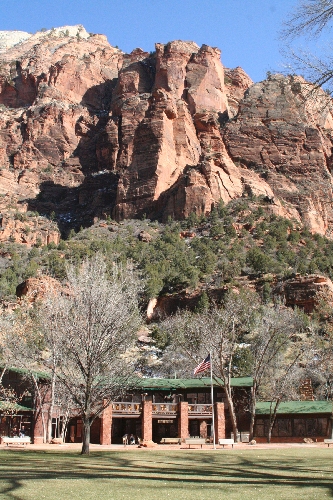Waterfalls, birds put on show in spring at Zion National Park
Zion National Park is one of the world's most famous destinations, on the bucket list for many an outdoor lover. How fortunate for us in Southern Nevada that it is practically in our own backyard. In less than a three-hour drive from Las Vegas you can be surrounded by a landscape of towering Navajo sandstone monoliths and deep canyons, with great diversity of plant and animal life. Whether you travel to Zion to hike, camp or just take the scenic drive, you will do so among some of the most stunning country on Earth.
The next couple of months are an ideal time to visit the park's lower elevations. The trees will be forming buds, leaves beginning to pop out, and the earliest wildflowers will start blooming. The spring air will be filled with the music of birds as they court and nest. This is often the best time to see waterfalls and cascades that pour off the cliff faces, tumbling thousands of feet down the walls, fed by melting snow and spring rains.
On a visit to Zion, bring clothes for all seasons. Average high temperatures in the main area of the park, at the Zion Canyon Visitor Center, are 63 degrees in March and 73 in April. But weather conditions are fickle in these months; a given day could be unseasonably warm or see snow. Furthermore, elevations in the park range from 3,666 feet in the southwestern part up to 8,726 feet in the northwestern section, so temperatures will vary widely even under the same weather conditions.
The most popular area of the park is Zion Canyon, which sits at about 4,000 feet in elevation. The seven-mile Zion Canyon Scenic Drive is one of the most dramatic places on Earth, winding its way among sandstone monoliths towering as much as 2,000 feet above.
The canyon also offers a wide choice of hiking trails, and hikers have many opportunities to see the park's protected and plentiful wildlife. Wild turkeys, famously reclusive in places where they are hunted, are commonly seen here, as are mule deer. There are 66 other types of mammals here, including rock squirrels, ringtails, porcupines, foxes, bighorn sheep and mountain lions.
As for birds, more than 280 species have been seen in Zion, including peregrine falcons, bald eagles and even the endangered California condor. Although they're more often seen in summer, condors have been sighted at Angel's Landing in Zion Canyon, at Lava Point up the Kolob Terrace Road and from the Canyon Overlook Trail, which starts at the east end of the Zion-Mount Carmel Tunnel.
One of the best trails for seeing the spectacular waterfalls of spring is the Riverside Walk. Flanking the North Fork of the Virgin River, it opens up a riparian environment of cottonwood trees, box elder, velvet ash and bigtooth maples. Most of these leaf out in April. Yet this is only a two-mile round trip, and is paved, so it's suitable for any age or ability. It's wheelchair accessible, with assistance, and popular for those with jogging strollers.
For more of Zion's water features, try the Lower Emerald Pool Trail. Although this 1.2-mile round-trip paved hike is spectacular year-round, spring puts on the grandest show of water pouring from the cliffs. In one area of the trail you will actually be underneath and behind a waterfall. You might get a bit muddy walking through here or even have some water sprayed on you, but that's a tribulation so unusual that most people just view it as a perk.
Across from the Emerald Pool Trail is the historic Zion Lodge, the only public accommodations actually within the park. The Western-style cabins are tops if you can get a reservation for one; they have gas-log fireplaces and private porches. Even if you are not fortunate to be staying at one of the 40 cabins or 81 motel rooms, the lodge is worth a visit. In its lobby you can sit in comfortable chairs to warm up after a hike, enjoy the historic photos on the wall and maybe stay for breakfast, lunch or dinner in the lodge restaurant.
The original Zion Lodge was built in the 1920s but succumbed to fire about 45 years ago. To accommodate guests it was rebuilt in a mere 100 days, but lost most of its visual charm. By 1992, management had realized the loss and remodeled the exterior to restore its classic looks. The cabins, which are on the National Register of Historic Places, were restored in the 1990s and simultaneously updated to modern standards. That made them my all-time favorite lodgings; I've found nothing to beat these cozy and very private accommodations, where merely opening the door admits one to an unspoiled natural place literally and appropriately named for heaven.
Through the end of March you can drive your own vehicle up Zion Canyon, but starting April 1 and on through Oct. 30 you need to take the park's free shuttle service. Buses are wheelchair accessible.
If you want to increase your enjoyment of the park, you might want to take one of the many educational workshops offered by the Zion Canyon Field Institute. It offers classes year-round on such topics as geology, photography, wildflowers and native plants. Some are simply hikes with highly expert guides, such as the institute's Thursday Treks or Wednesday Naturalist Walks. Thursday Treks run March 29, April 5 and May 3, and Wednesday Naturalist Walks run March 28 and April 25. Both of these are also offered throughout the year.
Other institute events are more in-depth workshops, such as one April 6 on Zion geology. This class features an indoor presentation followed by short hikes and trailside lectures. Participants will learn about the geologic forces that continue to shape this region, emphasizing the powerful role of water, especially the Virgin River.
"Zion through the Lens" is a photo workshop to be taught April 22 to 24 by institute director Michael Plyler, an award-winning photographer. The class will help budding photographers learn how to use a camera in manual mode as well as delve into topics including depth of field, exposure control, filters and composition. Many of the workshops can accommodate only limited numbers of participants and fill up fast, so reserve a spot early.
Back in 1919, when it became a national park, a little more than 1,800 people visited Zion; last year's visitation exceeded 2.8 million. Most of them visited during the warmer months from May to September, peaking in July. So if you're looking to witness Zion's wonders in something close to solitude, spring is the time to go.
IF YOU GO
Location: Zion National Park, near Springdale in Southern Utah, about 150 miles northeast of Las Vegas
Directions: From Las Vegas, take Interstate 15 north 125 miles to Utah Route 9 (Exit 16-Hurricane/Zion National Park). Follow Route 9 east to the main entrance of Zion National Park.
Zion National Park: (435) 772-3256. nps.gov/zion
Zion Canyon Scenic Drive Shuttle Bus: Travel up Zion Canyon Scenic Drive is by free shuttle bus only April 1 to Oct. 31.
Lodging: Zion Lodge, Zion Canyon Scenic Drive, (888) 297-2757, zionlodge.com; Cliffrose Lodge and Gardens, 281 Zion Park Blvd., Springdale, (800) 243-8824, cliffroselodge.com; Best Western Zion Park Inn, 1215 Zion Park Blvd., Springdale, (435) 772-3200, zionparkinn.com; Cable Mountain Lodge, 147 Zion Park Blvd., Springdale, (435) 772-3366, cablemountainlodge.com
Zion Canyon Visitor Center: Open daily 8 a.m.-5 p.m. through April 21, with extended hours the rest of the year.
Zion Human History Museum: Open daily 10 a.m.-5 p.m. starting March 2.
Junior Ranger Programs: A self-guided nationwide program for children ages 6 to 12. Booklets are available at all Zion visitor centers and Zion Human History Museum.
Zion Canyon Field Institute: Daylong and multiday workshops and service projects. Courses include geology, archaeology, plants, wildlife, photography and astronomy. Reservations requested. (435) 772-3264 or (800) 635-3959. zionpark.org.



















